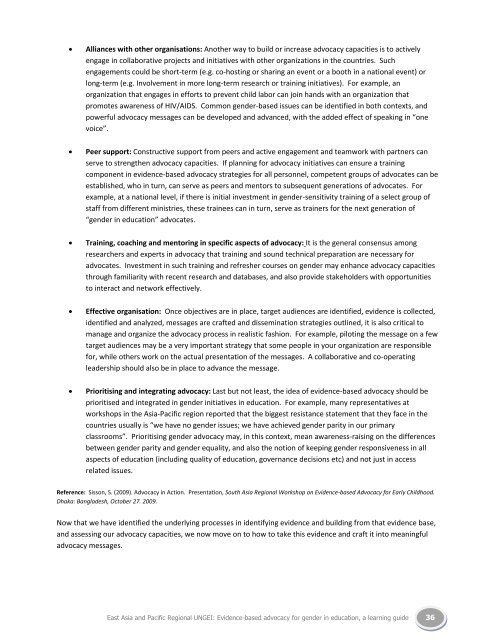Evidence-Based Advocacy - United Nations Girls' Education Initiative
Evidence-Based Advocacy - United Nations Girls' Education Initiative
Evidence-Based Advocacy - United Nations Girls' Education Initiative
You also want an ePaper? Increase the reach of your titles
YUMPU automatically turns print PDFs into web optimized ePapers that Google loves.
Alliances with other organisations: Another way to build or increase advocacy capacities is to actively<br />
engage in collaborative projects and initiatives with other organizations in the countries. Such<br />
engagements could be short-term (e.g. co-hosting or sharing an event or a booth in a national event) or<br />
long-term (e.g. Involvement in more long-term research or training initiatives). For example, an<br />
organization that engages in efforts to prevent child labor can join hands with an organization that<br />
promotes awareness of HIV/AIDS. Common gender-based issues can be identified in both contexts, and<br />
powerful advocacy messages can be developed and advanced, with the added effect of speaking in “one<br />
voice”.<br />
Peer support: Constructive support from peers and active engagement and teamwork with partners can<br />
serve to strengthen advocacy capacities. If planning for advocacy initiatives can ensure a training<br />
component in evidence-based advocacy strategies for all personnel, competent groups of advocates can be<br />
established, who in turn, can serve as peers and mentors to subsequent generations of advocates. For<br />
example, at a national level, if there is initial investment in gender-sensitivity training of a select group of<br />
staff from different ministries, these trainees can in turn, serve as trainers for the next generation of<br />
“gender in education” advocates.<br />
Training, coaching and mentoring in specific aspects of advocacy: It is the general consensus among<br />
researchers and experts in advocacy that training and sound technical preparation are necessary for<br />
advocates. Investment in such training and refresher courses on gender may enhance advocacy capacities<br />
through familiarity with recent research and databases, and also provide stakeholders with opportunities<br />
to interact and network effectively.<br />
Effective organisation: Once objectives are in place, target audiences are identified, evidence is collected,<br />
identified and analyzed, messages are crafted and dissemination strategies outlined, it is also critical to<br />
manage and organize the advocacy process in realistic fashion. For example, piloting the message on a few<br />
target audiences may be a very important strategy that some people in your organization are responsible<br />
for, while others work on the actual presentation of the messages. A collaborative and co-operating<br />
leadership should also be in place to advance the message.<br />
Prioritising and integrating advocacy: Last but not least, the idea of evidence-based advocacy should be<br />
prioritised and integrated in gender initiatives in education. For example, many representatives at<br />
workshops in the Asia-Pacific region reported that the biggest resistance statement that they face in the<br />
countries usually is “we have no gender issues; we have achieved gender parity in our primary<br />
classrooms”. Prioritising gender advocacy may, in this context, mean awareness-raising on the differences<br />
between gender parity and gender equality, and also the notion of keeping gender responsiveness in all<br />
aspects of education (including quality of education, governance decisions etc) and not just in access<br />
related issues.<br />
Reference: Sisson, S. (2009). <strong>Advocacy</strong> in Action. Presentation, South Asia Regional Workshop on <strong>Evidence</strong>-based <strong>Advocacy</strong> for Early Childhood.<br />
Dhaka: Bangladesh, October 27. 2009.<br />
Now that we have identified the underlying processes in identifying evidence and building from that evidence base,<br />
and assessing our advocacy capacities, we now move on to how to take this evidence and craft it into meaningful<br />
advocacy messages.<br />
East Asia and Pacific Regional UNGEI: <strong>Evidence</strong>-based advocacy for gender in education, a learning guide 36

















